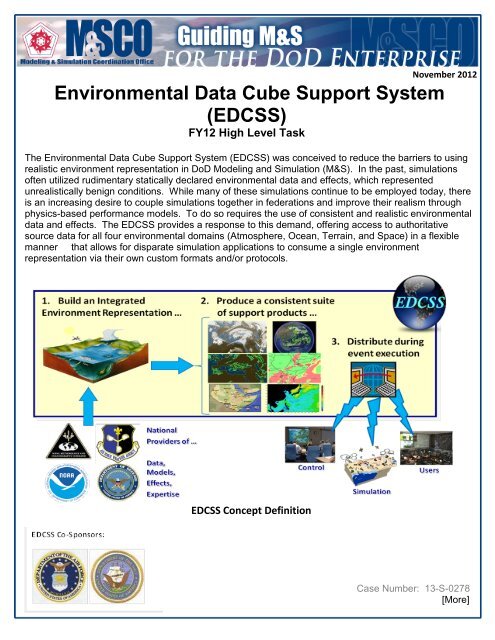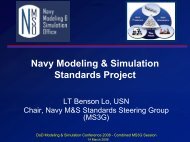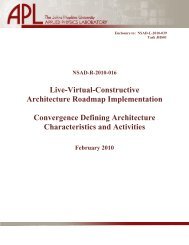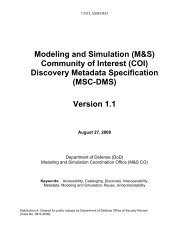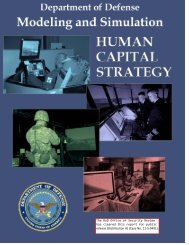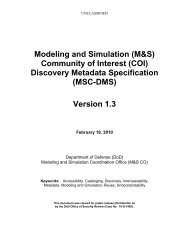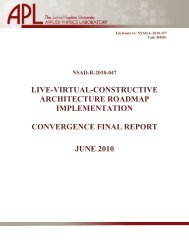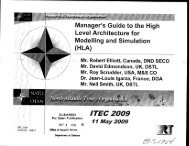Environmental Data Cube Support System (EDCSS) - Modeling ...
Environmental Data Cube Support System (EDCSS) - Modeling ...
Environmental Data Cube Support System (EDCSS) - Modeling ...
You also want an ePaper? Increase the reach of your titles
YUMPU automatically turns print PDFs into web optimized ePapers that Google loves.
<strong>Environmental</strong> <strong>Data</strong> <strong>Cube</strong> <strong>Support</strong> <strong>System</strong><br />
(EDCSS)<br />
FY12 High Level Task<br />
November 2012<br />
The <strong>Environmental</strong> <strong>Data</strong> <strong>Cube</strong> <strong>Support</strong> <strong>System</strong> (EDCSS) was conceived to reduce the barriers to using<br />
realistic environment representation in DoD <strong>Modeling</strong> and Simulation (M&S). In the past, simulations<br />
often utilized rudimentary statically declared environmental data and effects, which represented<br />
unrealistically benign conditions. While many of these simulations continue to be employed today, there<br />
is an increasing desire to couple simulations together in federations and improve their realism through<br />
physics-based performance models. To do so requires the use of consistent and realistic environmental<br />
data and effects. The EDCSS provides a response to this demand, offering access to authoritative<br />
source data for all four environmental domains (Atmosphere, Ocean, Terrain, and Space) in a flexible<br />
manner that allows for disparate simulation applications to consume a single environment<br />
representation via their own custom formats and/or protocols.<br />
EDCSS Concept Definition<br />
221<br />
Case Number: 13-S-0278<br />
[More]
The EDCSS is not itself an environmental database or model; rather it leverages source data and modeling<br />
capabilities from authoritative DoD and NOAA sources. The primary emphasis for EDCSS is to utilize<br />
relevant historical scenarios as the basis of its environment representation, however EDCSS technology<br />
can be employed to process live forecast data and products as well. EDCSS offers the ability to query,<br />
browse, and access source databases for reuse but also provides a project-centric user work flow that<br />
promotes the declaration of specific product and environment scenario requirements to which EDCSS can<br />
recommend the most appropriate resource to be used. An OV-1 is provided as Figure 1 below. In this way,<br />
consumers remain focused on their own requirements and not the ever changing landscape of source data<br />
and modeling capabilities.<br />
The EDCSS produces custom configured products in the form of <strong>Data</strong>, Effects/Impacts, Text, and Graphics.<br />
<strong>Data</strong> products include both standards-based formats and customer application-specific formats. Effects<br />
products capture the influence of the environment on specific military systems (e.g. sensors, vehicle<br />
performance, inter-visibility) and are provided in a novel multi-dimensional lookup table format referred to<br />
as a Hypercube. EDCSS also provides rule-based <strong>System</strong> Impact products that capture the nominal<br />
response of military systems to the underlying environment scenario. EDCSS Text products enable<br />
stimulation of operational Command and Control (C2) applications. EDCSS Graphic products provide<br />
customized views of the environment scenario and can range from simple graphics to simulated satellite<br />
imagery and radar products.<br />
In addition to coordinating production of a consistent suite of end-user environment representation<br />
products, EDCSS also offers technology for the distribution and integration of those products. The EDCSS<br />
Distributor is a lightweight web application that can be readily deployed on simulation networks to provide a<br />
single access and control point for all environment representation products a community requires. The<br />
Distributor offers both a web interface for human interaction and web services for automated download from<br />
consuming applications. To facilitate efficient ingest of data and effects products into simulation<br />
applications, and to minimize duplication of effort across the community, the EDCSS provides a Runtime<br />
Integration Module (RIM) that exposes straightforward Java and C/C++ language API’s for direct access to<br />
data and effects.<br />
The EDCSS has been under development by Atmospheric and <strong>Environmental</strong> Research (AER) since 2007,<br />
with program management by the <strong>Modeling</strong> and Simulation Executive Agents (MSEAs) for Atmosphere and<br />
Space Natural Environment (ASNE), Ocean, and Terrain. Funding for EDCSS development has been<br />
provided by the <strong>Modeling</strong> and Simulation Steering Committee as well as the US Air Force and US Navy.<br />
Today the EDCSS is a mature technology (TRL 7) routinely employed for Combatant Commander<br />
(COCOM) Joint Training and Mission Rehearsal Exercises (MRXs), Air Force Combat Air Forces<br />
Distributed Mission Operations (CAF/DMO), Navy Fleet Synthetic Training (FST), and the OSD Planning<br />
and Analysis communities. In 2013, EDCSS technology will begin transitioning to operational use at the<br />
Air Force Weather Agency (AFWA) as well as the Naval Warfare Development Command (NWDC).<br />
The EDCSS software is delivered to the government open-source and requires no commercial or proprietary<br />
software or hardware. EDCSS does not own, and therefore does not re-distribute, the environment data<br />
and modeling resources it employs. The EDCSS is a service oriented architecture (SOA), exposing all of<br />
its core functionality as well-defined services that can be integrated into other DoD Enterprise Architectures.<br />
Full information and documentation, as well as access to the system, is provided at https://ine.aer.com.<br />
222


